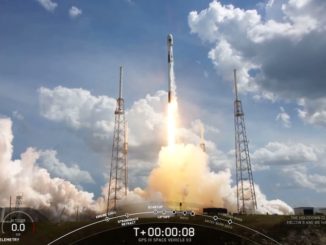
Two Earth-imaging microsatellites built and owned by the Argentine company Satellogic launched on a Long March 2D rocket from China Wednesday, sharing a ride into orbit with two Chinese spacecraft.
The ÑuSat 7 and 8 satellites — each about 45 kilograms (100 pounds) — lifted off on a two-stage, liquid-fueled Long March 2D rocket at 0253 GMT Wednesday (9:53 p.m. EST Tuesday) from the Taiyuan launch base in northern China’s Shanxi province.
The Long March 2D booster took off at 10:53 a.m. Beijing time and placed its four payloads into an orbit 300 miles (480 kilometers) above Earth with an inclination of 97.3 degrees to the equator, according to U.S. military tracking data.
Wednesday’s launch was successful, according to China Great Wall Industry Corp., the state-owned entity responsible for marketing and selling Long March launch services on the international market.
Two Chinese satellites launched on the Long March 2D booster alongside Satellogic’s two Earth-imaging payloads.
The largest spacecraft deployed by the Long March 2D rocket was a new satellite for the Jilin 1 fleet of Earth-imaging stations owned by Chang Guang Satellite Technology Co. Ltd. The Jilin 1 satellite delivered to space Wednesday has a new type of optical camera with a wide field-of-view and high resolution, and is also capable of high-speed data transmission, according to Chinese officials.
It was the 16th spacecraft launched in the Jilin 1 fleet since 2015.
A nanosatellite named Tianqi 5 — or Tianqi 2-03 in some reports — was also on Wednesday’s Long March 2D launch. The small Tianqi satellite was launched for Guodian Gaoke, a Beijing-based company, for a communication and data relay mission.

Satellogic says the two ÑuSat satellites launched Wednesday bring the company’s total number of spacecraft in orbit to 10.
Headquartered in Buenos Aires with a satellite manufacturing facility in Montevideo, Uruguay, Satellogic is building a fleet of satellites to cover the globe with visible, hyperspectral and infrared imagery. The company is one of several startups active in the commercial Earth-imaging market, along with Planet, BlackSky, ICEYE, and others.
Satellogic plans to deploy a fleet of 90 microsatellites primarily using Chinese rockets. The company inked a deal last year with China Great Wall to provide launch services for 90 small satellites on Long March 2D and Long March 6 rockets.
The ÑuSat 7 and 8 satellites launched Wednesday are based on Satellogic’s ÑuSat “Mark 4” design, and each spacecraft hosts a multispectral color camera with a resolution of about 3.3 feet, or 1 meter, and a hyperspectral imager with a resolution of about 100 feet, or 30 meters.
The new satellites are named Sophie and Marie after Sophie Germain, the mathematician and physicist, and Marie Curie, the physicist and chemist. Satellogic names its spacecraft after important women scientists.
Satellogic confirmed both new satellites were alive and healthy after Wednesday’s launch. Ground teams established communication with each spacecraft to begin post-launch commissioning and testing.
Satellogic says its satellite fleet will provide remote sensing, reconnaissance and environmental monitoring services for applications in agriculture, forestry, energy, finance and insurance, and critical infrastructure.
The company announced in December the conclusion of a $50 million funding round to scale up the satellite constellation.
Another ÑuSat microsatellite is slated to launch from French Guiana on an Arianespace Vega rocket in March, followed by a dedicated Long March 6 flight from China later this year with as many as 13 ÑuSat payloads.
Email the author.
Follow Stephen Clark on Twitter: @StephenClark1.



